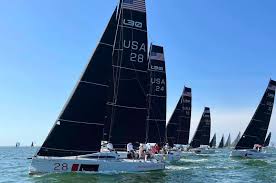Understanding the nuances of sailing tactics can often mean the difference between victory and defeat on the racecourse. In the realm of competitive sailing, critical decisions about maneuvering and right of way play a significant role.
Understanding Right of Way in Racing
When two boats are approaching each other on opposite tacks, the rules dictate that the starboard tack boat has the right of way. This implies that the port tack boat must yield. Yet, a well-timed hail can dramatically change the dynamics of the situation.
The starboard-tack vessel must decide whether to uphold its right of way or allow the port boat to cross its path. The context of the race can heavily influence this decision. The tactics adopted can lead to either retaining a tactical advantage or losing critical distance.
The Decision of ‘Tack or Cross’
When the port-tack vessel signals with a question, “Tack or Cross?” the starboard boat faces a choice laden with tactical implications. As noted by experienced racers, this call to action can either extend the starboard vessel’s lead or force a more defensive maneuver.
- If the starboard vessel desires to maintain its current direction, allowing the port vessel to cross may lead to turbulent air paths or potentially necessitate a cumbersome double tack to regain position.
- Conversely, permitting the port boat to pass can be a clever strategic retreat, sacrificing a momentary advantage for a more favorable positioning in upcoming legs of the race.
The Importance of Tactical Considerations
Racers should evaluate whether the port vessel could execute a successful lee bow tack. This maneuver could disrupt the starboard boat’s performance if not adequately considered. The starboard vessel must assess that the port tack boat is at least half a length ahead to necessitate the lee bow tack.
More often than not, when a port tacker poses the question, it does so in situations that allow for minor ducks—moves that demand little sacrifice from the starboard boat while permitting it to remain on its desired course.
Effective Communication Among Sailors
Clear communication between boats achieves paramount importance. Port tackers should signal early and distinctly to afford starboard boats adequate time to assess their options.
“It’s not enough to just say it once softly; it’s crucial to repeat clearly,” an experienced sailor emphasizes. Timing and visibility are critical, especially in noisy environments.
In larger crews, ensuring everyone comprehends the possible outcomes is vital even before any call is made, reinforcing the team’s readiness for any ensuing scenario.
Taking the Initiative
Rather than waiting for the port craft to instigate the dialogue, seasoned sailors advise starboard vessels to take the reins. For instance, declaring “cross, cross, cross” preemptively can dictate the course of action, pushing the port boat towards a less advantageous position.
This proactive approach not only retains control but also designs openings for future navigation. If the starboard vessel does not impose its preferred course, it risks finding itself at the mercy of the opposing port tacker.
Cultural Dynamics in Sailing Rules
Intriguingly, the racing regulations don’t explicitly state protocols for “tack or cross” inquiries. This aspect of racing is rooted deeply in cultural practices that have evolved to enhance cooperation and minimize conflict among vessels.
Encouraging goodwill and cooperation is crucial as experienced racers often allow others to cross their path, anticipating that such gestures will be reciprocated in future encounters. This dynamic fosters a community spirit and a smoother racing experience.
Guidance for New Sailors
Newcomers to racing may feel overwhelmed when seasoned sailors call out “tack or cross.” Understanding that this hail is a mere request, not an obligation, can empower inexperienced racers to make their own decisions without feeling undue pressure.
Ultimately, this perspective can help novice sailors develop confidence in their tactical choices while enjoying the thrill of sailing.
The Bigger Picture: Sailing and Exploration
In the wider context of sailing, understanding tactical maneuvers and communication not only enhances performance but also enriches the overall sailing experience. As GetBoat.com recognizes, every race and trip presents a new adventure, filled with opportunities to learn about local cultures and nature.
Exploring new shores and sea routes through boat rentals means tapping into multifaceted experiences that reveal not just the ocean’s beauty but also enrich one’s understanding of the locales encountered. Each bay, lagoon, and inlet is distinct and tells a story, similar to the regional cuisine, culture, and architecture.
If considering your next coastal journey, do plan on renting a boat that truly accommodates your quest for discovery, allowing you the freedom to unveil the secrets of the sea and its surroundings. Visit GetBoat.com for an array of enchanting options.
Your Next Steps
Looking ahead, the intricacies of such tactical sailing knowledge will significantly influence global sailing dynamics and tourism. By staying informed and competitive, sailors can not only enjoy their craft but also delight in the bountiful experiences aboard the various vessels offered by platforms like GetBoat, which epitomizes adaptability and user-centric service. Dive into your next adventure and seize the chance to explore uncharted waters!
In summary, mastering tactical decision-making in sailing is essential for ensuring enjoyable and successful maritime experiences. Engaging with platforms like GetBoat allows enthusiasts to discover a world of opportunities, linking them seamlessly to the heart of the oceanic experience. The excitement of yachting and all it entails awaits those ready to venture forth.

 Mastering Tactical Decisions in Sailing">
Mastering Tactical Decisions in Sailing">
